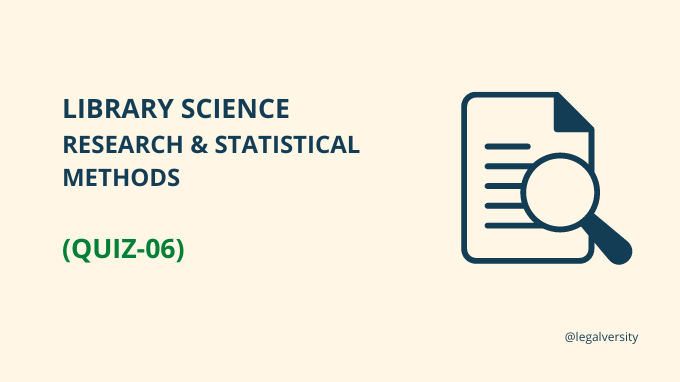LIS MCQs for Research & Statistical Methods. Here you will find the Library Science MCQs about Research & Statistical Methods. This is Quiz-6 of the Research & Statistical Methods MCQ series. If you are a student of Library and Information Management Sciences (LIMS) then these MCQs of Library Research & Statistical Methods are very important for you. In these MCQs, the Library Research & Statistical Methods are discussed.
The Research and Statistical Methods are discussed in multiple choice question and answer (MCQs).
LIS MCQs about Research & Statistical Methods
Find below the MCQs of Library Research & Statistical Methods.
251. The survey in which the same people are interviewed two or more times is known as:
A. Trend study
B. Panel study
C. Cross-sectional study
D. Descriptive study
➥ View Answer
252. The interview where the emphasis will be upon a given experience and its effect is known as:
A. Classical
B. Non-directive
C. Directive
D. Focused
➥ View Answer
253. Observation is probably the oldest method used by man in:
A. Social investigation
B. Scientific investigation
C. Technical investigation
D. Community investigation
➥ View Answer
254. Citizens attitude towards Public Library” was a survey conducted by:
A. Carlos Seymour
B. J .L. Schofield
C. Charles Evans
D. Marilee White
➥ View Answer
255. A method of exploring and analyzing the life of a social unit be it a person, family, an institution, cultural group or even an entire community is known as:
A. Case study
B. Evaluation
C. Survey
D. Observation
➥ View Answer
256. The author of “Performance Measures for Public Libraries” is:
A. LA
B. SLA
C. ALA
D. ILA
➥ View Answer
257. An evaluation study on Delhi University Library was conducted by:
A. George S. Bonn
B. Carl M. White
C. Peter Lazar
D. L. Carnovysky
➥ View Answer
258. An objective analysis of the appearance of words, phrases concepts, themes, characters, etc., is known as:
A. Text analysis
B. Theme analysis
C. Content analysis
D. Subject analysis
➥ View Answer
259. The system in which every occurrence of a given attribute is recorded is known as:
A. Frequency system
B. Intensity system
C. Appearance system
D. Time-space system
➥ View Answer
260. The inquiries into printed tools of librarianship books, journals, indexes, etc. is generally referred to as:
A. Bibliographical
B. Library Research
C. Book research
D. Documentary research
➥ View Answer
261. Bradford’s Law of Scattering has been further examined by:
A. B.C. Vickery
B. D.J. Foskett
C. D.W. Lang ridge
D. J. Mills
➥ View Answer
262. A complete list of all sampling units from which a sample is selected is called:
A. Sample unit
B. Sample universe
C. Sampling frame
D. Sample population
➥ View Answer
263. The standard deviation of the sampling distribution is known as:
A. Sampling error
B. Standard error
C. Sampling fraction
D. Sampling unit
➥ View Answer
264. The variables which are measurable and objectively verifiable are known:
A. Quantitative
B. Qualitative
C. Collective
D. Numerical
➥ View Answer
265. The value of the variable having maximum frequency is known are:
A. Mean
B. Median
C. Mode
D. Range
➥ View Answer
266. The statistical technique which measures the association between two nominal variables or between nominal and ordinal variables is known as:
A. Correlation coefficient
B. Contingency measure
C. Chi-square
D. Simple regression
➥ View Answer
267. The proofreading of data to catch and correct errors and inconsistent codes is known as:
A. Data Editing
B. Data cleaning
C. Data mining
D. Data coding
➥ View Answer
268. SPSS software for statistical analysis is meant for:
A. Management
B. Psychology
C. Humanities
D. Social sciences
➥ View Answer
269. MS Excel is one of the most powerful software for electronics:
A. Files
B. Database
C. Spreadsheets
D. Websites
➥ View Answer
270. Harvard Graphics (HG) is an application program developed by:
A. Microsoft
B. Intel
C. Bell labs
D. Software publishing corporation
➥ View Answer
271. The horizontal axis m a graph is called:
A. X axis
B. Y axis
C. Z axis
D. A axis
➥ View Answer
272. The method of depicting the data through geometrical figures is known as:
A. Cryptogram
B. Hexagram
C. Histogram
D. Genogram
➥ View Answer
273. The author of the book How to get a Ph.D. is:
A. M. Meyer
B. E.M. Philips
C. R.A. Day
D. G. Watson
➥ View Answer
274. Measuring the productivity of an author based on a number of publications led to the emergence of:
A. Bradford Law
B. Zipf Law
C. Brookes Law
D. Lotka Law
➥ View Answer
275. The analysis of information productivity patterns is known as:
A. Bibliometrics
B. Informatics
C. Bookiometrics
D. Librametrics
➥ View Answer
276. The general theory of ‘Cumulative Advantage Process’ was expounded by:
A. S.C. Bradford
B. E. Garfield
C. F. Machlup
D. Derek De Solla Price
➥ View Answer
277. The first attempt to analyze the relationship between the cited and citing documents was made in 1972 by:
A. Gross
B. E. Garfield
C. Kessler
D. L. Egghe
➥ View Answer
So, these are the MCQs 201-277 for Library Research & Statistical Methods.
MCQs of Library Research & Statistical Methods
Topics Related to Library Science Subject:
- Information Processing
- LIS MCQs of History & Development
- Data Processing & Retrieval Techniques
- Research Methodology
- Library and its Users
- Library and Information Centers Management
- Knowledge & Disaster Management
- Information System and Programs
- Reference and Information Services
- All other Library Science MCQs

